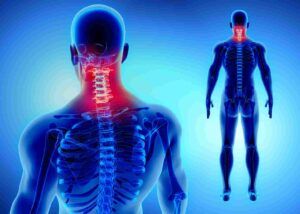If you are one of the millions of people who suffer from cervical radiculopathy, you know how painful and debilitating it can be. This condition is caused by compression or irritation of the nerve roots in the cervical spine and can result in pain, numbness, tingling, and weakness in the neck and shoulders. In this guide, we will discuss a variety of exercises that can help relieve the symptoms of cervical radiculopathy.
Contents
What Are Cervical Radiculopathy Exercises?
Cervical radiculopathy exercises are a set of physical activities that are specifically designed to target the muscles and tissues in the neck region. These exercises help to relieve pain and discomfort, improve mobility and flexibility, and strengthen the cervical spine overall.
Symptoms
There are various symptoms of cervical radiculopathy.
These are as follows:
- Pain, numbness, and tingling in the neck, shoulders, arms, and hands
- Reduced range of motion in the cervical spine
- Weakness in the muscles of the neck and upper body
So these are some of the most common symptoms associated with this condition.
Causes
There are many possible causes of cervical radiculopathy, including:
- Trauma or injury to the muscles and joints in the neck and upper body
- Weakening or bulging discs in the spine that put pressure on nerve roots in the neck or upper body
- Herniated discs or other conditions that cause compression of the spinal cord
- Other underlying medical conditions such as arthritis, osteoporosis, diabetes, and thyroid disorder.
So these are the causes of cervical radiculopathy.
What Activities Should Be Avoided With Cervical Radiculopathy?

One of the most important things to keep in mind when dealing with cervical radiculopathy is that certain activities and exercises should be avoided at all costs. These include:
- Heavy lifting or strenuous physical activity, as can exacerbate your symptoms and cause further damage to the nerves in your cervical spine.
- Any form of twisting or turning of the neck puts increased pressure on the injured nerve roots. This includes activities like yoga and Pilates.
- Prolonged periods of sitting or standing, as can increase tension in the neck and upper back muscles.
Fortunately, there are plenty of exercises and activities that can help you manage your symptoms and reduce pain and inflammation.
Types Of Cervical Radiculopathy Exercises

There are many different types of cervical radiculopathy exercises that you can try in order to manage your symptoms and improve your overall health. Some of the most common exercises for cervical radiculopathy include stretching, strengthening, and range-of-motion exercises.
Stretching
Stretching is an important part of any exercise routine for people with cervical radiculopathy. There are several different stretches that you can try, such as neck stretches, upper body stretches, and lower back stretches. These types of exercises can help to increase flexibility and range of motion in your neck and other affected areas.
Strengthening exercises
Another important group of cervical radiculopathy exercises is strengthening exercises. These types of exercises typically involve using resistance bands or weights to strengthen the muscles around the spine and neck. Strengthening exercises can help to improve your posture, prevent further injury, and support the affected areas of your body.
Range of Motion
Finally, range-of-motion exercises are also an essential part of any cervical radiculopathy exercise routine. These types of exercises involve gently moving different parts of the body to keep them flexible and mobile. Range-of-motion exercises can also help to improve your overall posture and prevent stiffness in the neck and other affected areas.
If you are looking for effective ways to manage your cervical radiculopathy symptoms, then be sure to incorporate a variety of different types of exercise into your routine. Whether you choose stretching, strengthening, or range-of-motion exercises, you can be sure that these activities will help to improve your overall health and well-being. So why wait? Start incorporating some of these exercises into your daily routine today, and experience the many benefits of cervical radiculopathy exercise for yourself!
How To Manage It?
One of the most important things when it comes to exercises for cervical radiculopathy is to focus on strengthening and stretching the neck muscles. Some great exercises for this include:
Neck rotations
This involves turning your head slowly to the left and right, making sure to keep your chin level, and looking straight ahead. For instance, you can start with a gentle stretch and then gradually work up to more intense stretches. Repeat this process on the other side as well, making sure to keep your chin level as you rotate your head.
Shoulder shrugs
This exercise involves lifting your shoulders up towards your ears, holding them for a few seconds, and then lowering them back down. You should aim to do this exercise several times throughout the day, focusing on really engaging your neck muscles as you lift and lower your shoulders.
Neck flexion
This involves tilting your head down and bringing your chin towards your chest. Then, gently return to starting position by raising your head back up. For instance, you might choose to do this exercise while sitting at your desk, or even watching TV.
Neck extension
This involves tilting your head back and bringing your chin towards the ceiling. Then, gently return to starting position by lowering your head back down. You can perform this exercise while standing or lying on the floor, depending on what is most comfortable for you.
Chin tucks
This exercise involves pulling your head in towards your chest while keeping the rest of your body still. You can do this by tilting your head back slightly and gently pressing down on the top of the neck with both hands.
Arm circles
Arm circles are another great exercise to help improve flexibility in your cervical spine. To do arm circles, simply lift one arm out to the side at shoulder height and make circular motions with your arm, rotating it in both directions. This can help to loosen up tight muscles and promote a better range of motion in your neck and upper back.
Progressive muscle relaxation
This involves tensing different parts of your body for a few seconds at a time, then relaxing those muscles. For instance, you might start by tensing your shoulders, then relaxing them. Once you have fully relaxed your body, focus on the pain in your neck and try to relax any tension that may be contributing to it.
Stretching exercises
Stretching can help to loosen up tight muscles and relieve pressure on the nerve roots affected by cervical radiculopathy. There are many different stretches that you can try, such as neck and shoulder rolls, neck flexion, chin tucks, and shoulder shrugs.
Acupressure
Acupressure is a form of massage therapy that focuses on applying pressure to certain points in your body using your fingers or hands. These pressure points are thought to be linked to certain organs and bodily functions, and applying pressure to them can help you relieve tension in your muscles and decrease pain. There are many acupressure points that can help with cervical radiculopathies, such as the temple point on your head or the supraclavicular point between your collarbone and shoulder.
Ice and heat therapy
Applying ice to the affected area is a great way to reduce inflammation and swelling, which can help relieve pain. Similarly, using heat packs or heating pads on the painful area may also provide some relief by increasing blood flow and soothing sore muscles.
These are just some of the many exercises that can help to strengthen and stretch your neck muscles. By incorporating them into your daily routine, you can better manage your cervical radiculopathy and improve your overall quality of life. So start incorporating these exercises today, and see how much they can help!
In addition to these exercises, it is also important to focus on relaxation and breathing techniques. This can help reduce stress and tension in the neck muscles, which can further improve your symptoms.
Relaxation Techniques
This involves taking slow, deep breaths, and focusing on expanding your belly as you inhale. For instance, you might try sitting in a comfortable position and taking several deep, slow breaths. This is an excellent exercise for improving your overall flexibility and circulation, which can help to reduce pain and stiffness associated with cervical radiculopathy.
Ultimately, when it comes to managing and treating cervical radiculopathy with exercises, it is important to be patient and consistent. With the right plan in place and a little bit of time and effort, you can gradually improve your symptoms and regain full mobility and function in your neck. So start incorporating these exercises into your daily routine today, and you will surely see results!
Conclusion
It may be concluded that cervical radiculopathy exercises can be highly beneficial in helping to manage the symptoms of this condition, and can even help to prevent it from worsening over time. These exercises are designed to strengthen and stretch the muscles around your cervical spine, which will help to alleviate pain, improve mobility, and increase stability in that area.
Some of the most effective exercises for cervical radiculopathy include neck rotations, head tilts, and shoulder shrugs. These exercises can be done on your own at home, or with the help of a physical therapist or other healthcare providers.
Practice, and you will start to see improvements in your symptoms and enjoy a better quality of life overall. And remember, always consult with your healthcare provider before starting any new exercise routine or modifying an existing one.
Physical Therapy help patients recover from pain. If you’re experiencing Back pain, Shoulder pain, Knee pain, Neck pain, Elbow pain, Hip pain, or Arthritis pain, a physical therapist at MantraCare can help: Book a physiotherapy session.


